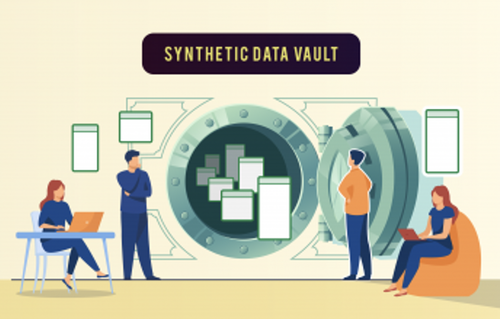Real Promise of Synthetic Data

Veeramachaneni and his team first tried to create synthetic data in 2013. They had been tasked with analyzing a large amount of information from the online learning program edX, and wanted to bring in some MIT students to help. The data were sensitive, and couldn't be shared with these new hires, so the team decided to create artificial data that the students could work with instead — figuring that “once they wrote the processing software, we could use it on the real data,” Veeramachaneni says. High-quality synthetic data — as complex as what it's meant to replace — would help to solve this problem. Companies and institutions could share it freely, allowing teams to work more collaboratively and efficiently. Developers could even carry it around on their laptops, knowing they weren't putting any sensitive information at risk.
In 2016, the team completed an algorithm that accurately captures correlations between the different fields in a real dataset — think a patient's age, blood pressure, and heart rate — and creates a synthetic dataset that preserves those relationships, without any identifying information. When data scientists were asked to solve problems using this synthetic data, their solutions were as effective as those made with real data 70 percent of the time. The team presented this research at the 2016 IEEE International Conference on Data Science and Advanced Analytics.
For the next go-around, the team reached deep into the machine learning toolbox. In 2019, PhD student Lei Xu presented his new algorithm, CTGAN, at the 33rd Conference on Neural Information Processing Systems in Vancouver. CTGAN (for "conditional tabular generative adversarial networks) uses GANs to build and perfect synthetic data tables. GANs are pairs of neural networks that “play against each other,” Xu says. The first network, called a generator, creates something — in this case, a row of synthetic data — and the second, called the discriminator, tries to tell if it's real or not. “Eventually, the generator can generate perfect [data], and the discriminator cannot tell the difference,” says Xu. GANs are more often used in artificial image generation, but they work well for synthetic data, too: CTGAN outperformed classic synthetic data creation techniques in 85 percent of the cases tested in Xu's study.

The Synthetic Data Vault combines everything the group has built so far into “a whole ecosystem,” says Veeramachaneni. The idea is that stakeholders — from students to professional software developers — can come to the vault and get what they need, whether that's a large table, a small amount of time-series data, or a mix of many different data types. The vault is open-source and expandable. “There are a whole lot of different areas where we are realizing synthetic data can be used as well,” says Sala. For example, if a particular group is underrepresented in a sample dataset, synthetic data can be used to fill in those gaps — a sensitive endeavor that requires a lot of finesse. Or companies might also want to use synthetic data to plan for scenarios they haven't yet experienced, like a huge bump in user traffic. As use cases continue to come up, more tools will be developed and added to the vault, Veeramachaneni says. It may occupy the team for another seven years at least, but they are ready: “We're just touching the tip of the iceberg.”
For more detail, please click here.
